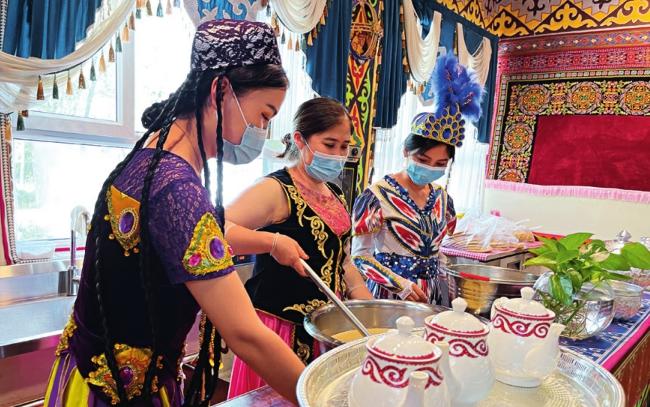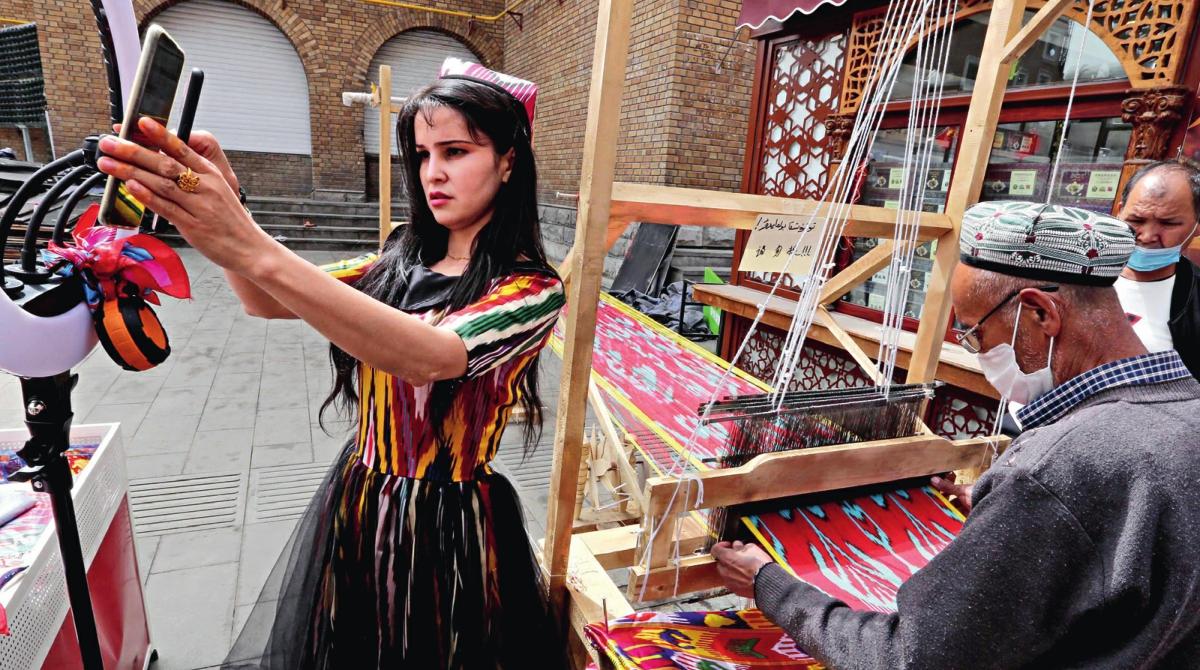Xinjiang in My Eyes
By staff reporter MAHITAB AHMED


ON May 24, 2021, I boarded a flight to Urumqi from Beijing with a group of Chinese and foreign journalists to learn more about Xinjiang Uygur Autonomous Region, a vast territory that is home to many ethnic groups and diverse cultures. The visit has left me with lasting memories and a deeper understanding of the people and the region as a whole.
The Beauty of Xinjiang — Nalati
“If you dont come to Xinjiang, you wont know the beauty of China. If you dont come to Nalati, you wont know where that beauty is.”From the observation platform constructed to best take in the scenery, the azure blue sky, towering green hills, snow-capped mountains under white clouds, vast grasslands, and herds of cows, sheep, and horses create a peaceful and postcard image that will be long remembered by everyone who sees it.
Nalati is known as the “Entrance to Heaven on Earth” and the “Realm of Heaven on Earth.” It has a unique topography, with green hills on three sides, and a river crossing the central part. The raised hillsides are called saddles, as it brings to mind an image of people riding on horseback enjoying the beautiful scenery of the grassland.
According to local herdsmen, Nalati means the first place to see the sun. Located in Xinyuan County, Ili Kazak Autonomous Prefecture, in the eastern section of the Ili River Valley, Nalati has an average elevation of 1,800 meters and a total planned area of 960 square kilometers. There are 27 main tourist attractions in this scenic area.
Multi-ethnic Harmony — Tacheng
Xinjiang is a place where more than a dozen ethnic groups have lived in harmony for a long time. In Tacheng, located in the northwestern part of Xinjiang and the southern end of the Junggar Basin, the long history, culture, and unique ethnic customs have had a profound influence on its development. We visited several multi-ethnic families there to find out more about the cultural exchanges among various ethnic groups in Tacheng, and how they pass on their traditional cultures, and also share these in the form of singing and performances.
The Haerdun residential community in Tacheng is very representative of multi-ethnic harmony. It is home to 14 ethnic groups including Han, Kazak, Hui, and Uygur. Residents of all ethnic groups in the community have lived in harmony as a family, thus winning the community the honor of National Model Group of Ethnic Unity and Progress two times in 2014 and 2019. Visiting the house of Wureken in Haerdun, we saw a group photo hanging on the wall. In the photo, family members from four ethnic groups were dressed in their own distinctive costumes and surrounded a middle-aged man. Wureken and his four sisters are from the Kyrgyz ethnic minority group. They are all married to people from other ethnic groups.
“My four brothers-in-law are Mongolian, Kazak or Han, and I have a Mongolian wife,” said 49-yearold Wureken. Their marriages were “masterpieces”of love and were supported by their parents. “My mother has always told us since we were children that ethnic unity is of great importance,” said Wureken.
He said everyone in the family played with chil-dren of different ethnic groups when they were young, and his mother also has many good friends of different ethnic groups.
“We are all Chinese, and we belong to one family. As long as everyone thinks in a united way, life will keep improving.”
Halidan Idahongs family runs a restaurant in the Haerdun residential community. Her family is also of ethnic diversity. She is Uygur, her husband is Uzbek, her eldest sisters husband is Tatar, her younger sisters husband is Kazak, and her younger brother Du Ronglu is Han.
The story behind her having a Han brother dates back to early 1986, when Du came to look for employment in Tacheng from east Chinas Shandong Province. At that time, he was frail and had no work experience, making it difficult for him to find a job. The weather was cold and there was nowhere to stay. The money he had brought was very little. After Halidans father Idahong heard about this situation, he asked Du to come to his home to help him with livestock herding. Living together enabled Du to establish a deep relationship with the family.
Du, being the same age with Idahongs own children, was gradually accepted as a member of the family. He lived with the family for seven years, and later returned to his hometown. Before leaving, the father gave Du all his family savings of RMB 17,000 so that Du could start a family in his home- town. Now the two families, despite being apart geographically, are in close contact with each other. They often gather together and share special food of their respective culture to celebrate festivals.
Innovation and Inheritance
Nang is a type of leavened flatbread and a staple food for people of all ethnic groups in Xinjiang. When Xinjiang is mentioned, everyone thinks of nang. Visiting the Yilihe Nang Cultural Town to experience its culture and innovation was an interesting experience.
The town is an industrial park that integrates nang baking, cultural experiencing and sightseeing, with a total construction area of 5,310 square meters. The two-storey manufacturing area covers 3,810 square meters. The first floor is mainly for production, display, and sales of 32 varieties of nang. The second floor is the baking area, which mainly produces nang of different flavors ranging from rose, spice, walnut and raisin, and milk.
The Milk Tea Culture Experience Hall covers an area of 750 square meters, with a sales area, milk tea experience area, Kazak folk culture exhibition area, and other areas. There are also more than 100 kinds of local farm products on offer, including dried apricot slices, and honey and dairy products. At present, the innovation of nang culture is growing, and the unique staple food has been exported overseas and won popularity among consumers.
To appreciate the inheritance of intangible cultural heritage, a visit to the Yiman Courtyard in Tacheng is a must. Located on Jiefang Road, it is a centennial Tatar courtyard. It is named after several-hundred-year-old oak trees, literally the meaning of Yiman, in the courtyard. Tatar Refati and Zaitunna are the owners of this courtyard. Zaitunna serves as the chairperson of the Tatar Cultural Association of Tacheng Prefecture and is an inheritor of national intangible cultural heritage.
The Tatar is an ethnic minority with a small population in China. The Tatar Saban Festival was included in the second batch of the National List of Intangible Cultural Heritage. The courtyard was built by Zaitunna, who hoped people could better understand the Tatar people, and preserve its traditional food and pastry making skills. Traditional Tatar pastries are famous for their recipes, skilled techniques, and natural tastes. As a genuine piece of Tacheng culture, the pastries have become the sought-after gifts for relatives and friends. At present, the courtyard is the best place to experience the customs of the Tatar people in Tacheng.
Overcoming Poverty — Horgos
During my visit, I was struck by the development of Xinjiang. In order to uplift more areas out of poverty, the Chinese government has made great efforts in Xinjiang and has been continuously supporting the development of local industries, and helping local residents eliminate poverty through economic and tourism development. The focus is set on making sure locals have a sustainable income and the capacity to improve their quality of life.
Horgos was an important postal station on the Ancient Silk Road. Bordering Kazakstan, it is Chinas closest port to Central Asia and Europe by land transport.
We visited Horgos Jinyi International Trade Co., Ltd. in the Horgos Economic Development Zone. Founded in 2010, the company integrates vegetable and fruit planting, transportation, storage, processing, and sales. Its products are exported to Central Asian countries and Russia.
International customers can order specific agri- cultural products, such as peppers, tomatoes, oranges, apples, nectarines, sweet peppers, and other vegetables and fruits from the agricultural product maker. The company funds local farmers in vegetable and fruit planting. After the harvest, it purchases the farm produce and transports it to its 20,000-squaremeter refrigerated warehouse for further processing and packaging on demand. The company exports 60,000 tons of agricultural products to Central Asia every year, with a trade volume of US $100 million.
Jinyi is a leading agricultural company in Xinjiang. It has established fruit and vegetable production bases totaling around 7,000 hectares across the country. The company has helped more than 1,000 rural households increase their incomes and created close to 300 temporary jobs daily on average.
Even during the COVID-19 pandemic, the company managed to deliver fresh produce and reliable agricultural products to international customers.
The above descriptions are just some of the things I saw during the trip to Xinjiang. I not only saw beautiful scenery and experienced local customs of various ethnic groups, but also witnessed Xinjiangs progress. Visiting the region has left a deep impression on me, and I look forward to returning some time in the future.

